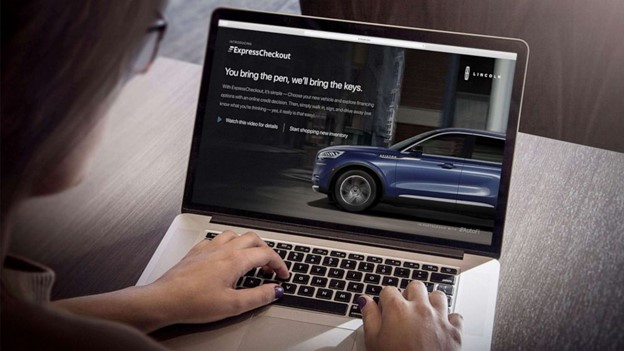Chinese Modus Operandi In Africa
In the last two decades, China has become the most important economic interlocutor of the African continent, through a number of both public and private initiatives across trade, investments, financing and cooperation. To have an idea of the scale of the Chinese wave, we can have a look at the most recent figures.
In the list of main investors in Africa by FDI stock, China is placed only at the 4th position. However, the recent trend does not leave room to interpretation: while the top 3 countries investment remained pretty much unchanged in the period 2011-2016, China’s FDI assets in the continent grew at an impressive +150% rate.
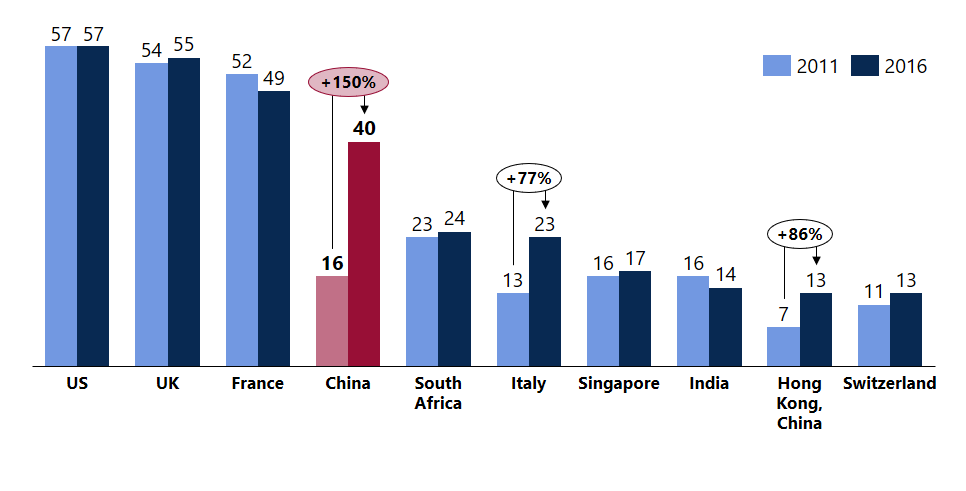
China is also the economy that by far announced the largest amount of greenfield projects in Africa in 2016, with over USD 36 billion, being only second to Italy last year.
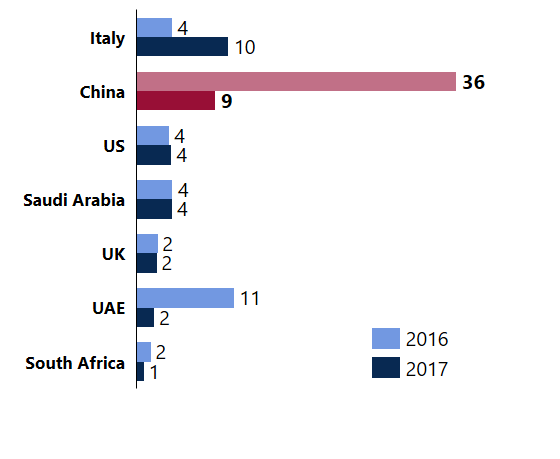
In addition, Afro-Chinese trade has been growing at ~20% per year, almost for the last two decades.
Finally, it is important to note that these figures do not necessarily take into account the Chinese capital flowing through Hong Kong, where many Chinese giants have their holding company, through tax havens such as the Cayman Islands or the British Virgin Islands, or through other less transparent channels.
The size and the pace of the phenomenon has provoked different reactions, ranging from an absolute consent for the pragmatism and, above all, the capital that was brought to Africa, to the fear for a quite fluid but rampant operation of neocolonialism. Chinese activities on the African continent are often perceived as a monolithic, state-coordinated investment whose reins are directly in the hands of the Chinese Communist Party – but this is only one side of the story.
Reality shows that Chinese operations in Africa, whether public or private, are carried out according to a multitude of modus operandi.
1 – The Belt and Road Initiative
Launched by the PRC Government in 2013, the BRI has recently been defined by the Chinese vice-minister for foreign affairs as an “effort to build a more fair and equitable international order and to reform the global economic governance structure”, and as a response to the trend of rising protectionism, unilateralism bullying and anti-globalization.
In more practical terms, the BRI consists of a gigantic scheme to finance and build infrastructure, ventures and other business initiatives across ~20 are Africans countries, among the 87+ countries worldwide involved till today. The total estimated value of all the deals announced within this initiative since the launch is USD 1.12 trillion, of which a large proportion is earmarked for projects on the African continent, especially in areas such as: transportation, power & energy, but also in shipping, minerals & mining, manufacturing, petrochemical, real estate, telecommunications, and agriculture. South Africa and Ethiopia are among the countries that are most benefiting from BRI related investments.
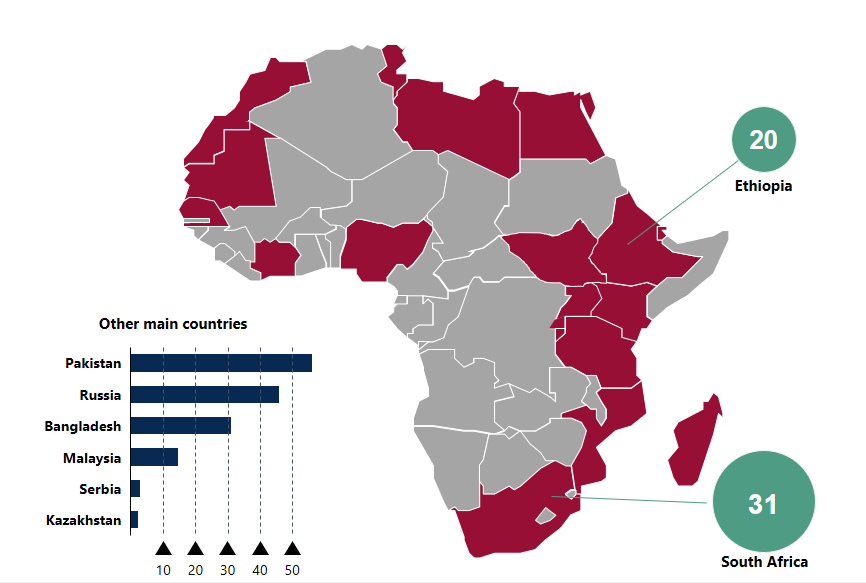
(figures in USD billion)
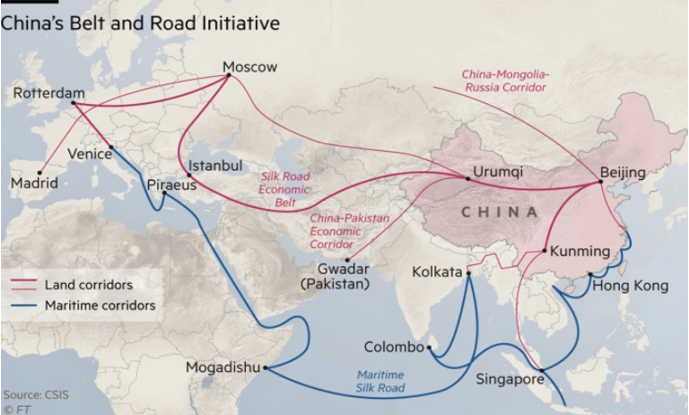
(figures in USD billion)
Despite the fact that the boundaries of the BRI are quite fluid, several mega-projects are considered part of it, including the USD 3.5 billion International Free Trade Zone to be realized in Djibouti, the Mombasa-Nairobi standard gauge railway in Kenya, the Addis Ababa-Djibouti railway and the recently inaugurated cross-sea bridge in the Maputo bay, and many other much needed infrastructures.
However, the BRI is no charity, nor is it a multilateral mechanism like the United Nation or the World Bank: each country deals individually with China, negotiating the financial schemes, establishing the project conditions and deciding how the infrastructure will be managed and by who.
Projects are mostly carried by state-owned companies (State Grid Corporation, CNPC, Sinopec and CRCC are among the most the top 10, but the list also includes private giants such as Alibaba and Huawei) and financed by state-funded banks, such as the Exim Bank of China and the China Development Bank.
Obviously, the BRI is not the only way in which the Chinese government is leading the interaction with the African continent. As of today, 53 African countries have established diplomatic and cooperation relationships with China and the African Union, also through the participation to the yearly Forum on China-Africa Cooperation. Moreover, Chinese leaders personally visit African countries with a certain regularity, which is a form of diplomacy carrying not only a symbolic weight. For instance, the Chinese foreign minister makes an annual visit to the continent at the beginning of each year and over the last ten years government leadership made 79 visits to 43 different countries, with quite a preference for South Africa (7) and Tanzania (4).
2 – Private investments
Chinese investment in Africa is more market-oriented than is commonly thought.
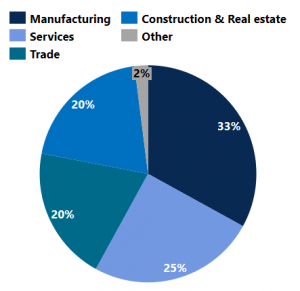
Around 10,000 Chinese firms are currently estimated to operate in the African territory, 90% of which are privately owned and operating in several sectors of which they already handle relevant shares:
· 12% of Africa industrial production
· 50% of Africa internationally contracted infrastructure construction.
In most cases, Chinese private operators prefer long-term investments rather than trading or contracting, and have their focus on serving African markets rather than exporting their products.
This strategy led a third of them to reach profit margins higher than 20% and their consolidated revenues, that are currently estimated at USD 180 billion, are expected to range between 250 and 440 USD billion by 2025.
An aggressive price strategy is often the key for success: in some cases, these firms lowered their prices for existing products and services by 40% and remained profitable through the introduction of an improved technology or by getting efficiencies of scale.
Private investments from China into African markets come to seize business opportunities with a simple profit-oriented logic and can get so competitive that not even smugglers can make it against them. For instance, the Lee Group that produces, among other products, 1.2 million flip-flops per day, and sell them for around 1 USD a pair, keeping a ~100% market share across Nigeria and West Africa.
3 – Industrial Zones
Halfway between public initiative and private investment there is the creation of industrial zones, often starting with the state leadership negotiating spaces, fiscal incentives and other conditions and getting local government authorization and support. A public company will then plan and develop the industrial zone, promoting the created opportunity among other Chinese private investors.
To this extent, by the end of 2016 Chinese enterprises had built 56 economic and trade zones in more than 20 countries along the Belt and Road routes, with an accumulated investment of over USD 18.5 billion. China Merchants Group, a state-owned USD 90 billion industrial conglomerate, is believed to be the government tool to unlock foreign markets by exporting its model of industrial zone development. It is not surprising that the company’s international trajectory is very evocative of the BRI itself.
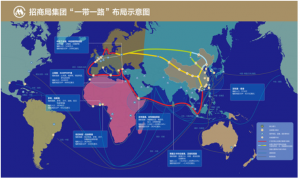
This model was the one applied for the Great Stone project, an industrial park designed to bring together some USD 30 billion of Chinese investments in Belarus. It is likely that CMG will apply the same model to the above-mentioned Free Trade Zone in Djibouti and the one linked to the Bagamoyo port in Tanzania, being this a strategy very much welcomed by local governments and labor markets.
However, the State initiative is not the only driver that leads to the development of Chinese industrial zones.
In Africa, besides the 7 industrial zone approved by the Chinese Ministry of Commerce in Ethiopia, Algeria, Egypt, Mauritius, Nigeria (2) and Zambia, private investors have established further zones in Botswana, Guinea, Nigeria again and South Africa, directly dealing with local governments since the year 2000.
4 – Foreign debt
From 2000 to 2017 the Chinese Government, banks and contractors extended USD 143 billion worth of loans to African governments and state-owned enterprises. Whether or not these loans are value for money or just a flow of money from the Chinese government to Chinese companies via Africa remains a matter of debate.
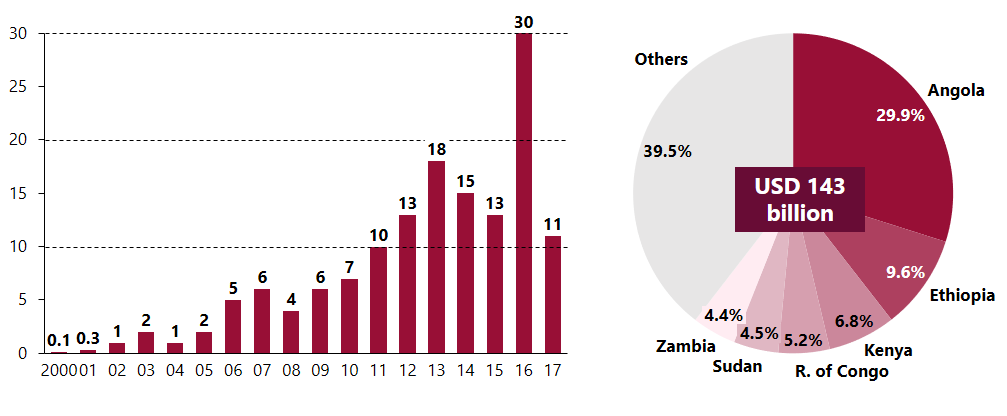
The nature of loans is much varied. Some of them qualify as official development aid, but others are export credits, suppliers’ credit, commercial loans, etc.
These amounts are not current debt figures, since many countries have been paying back their debts promptly and substantially along the years. However, doubts are raised about the ability of many countries to sustain relatively large debts. This is the case of Kenya, whose bilateral debt is currently 72% owned by China, or Djibouti and Maldives, whose total debt is estimated to reach respectively around 90% and 65% of the country’s GDP, once the Belt & Road Initiative will be completed.
5 – Military presence
At the time when the US and the European countries are adopting isolationist policies, Beijing is making power moves in Africa, projecting China as the leader of the developing world, in solidarity with developing nations through the fight against terrorism, piracy and natural disasters. Of course, the desire of safeguarding Chinese workers and Chinese-funded projects on the continent is likely playing a role in the government’s efforts as well.
The military presence in Africa has been fortified in different ways. Primarily, by establishing its first overseas military base in Djibouti. Secondarily, by taking a more active role at the United Nations, becoming the major contributor of peacekeepers and one of the largest contributors of troops. Tertiarily, by providing logistical and defense support, technology, equipment, personnel, strategic advice and weapons, as announced at the first ever China-Africa Defense and Security Forum.
6 – Soft power
Chinese initiatives to increase influence in the African continent include also some other forms of soft power that may or may not be part of a unique comprehensive strategy.
Chinese Yuan as a reserve currency
From one side, the government push to internationalize its currency is part of the strategy to promote trade and investments. From the other side, most African countries have loans or grants from China and for them it would make economic sense to repay in Chinese Yuan.
For these reasons, African central bank leaders are currently discussing whether to hold the Yuan as part of their foreign reserves. This discussion is currently held by 14 nations in Eastern and Southern Africa, including Angola, Botswana, Burundi, Kenya, Lesotho, Malawi, Mozambique, Namibia, Rwanda, Swaziland, Tanzania, Uganda, Zambia and Zimbabwe.
Diplomatic boost and tourism
Africa is becoming more and more an appealing destination for Chinese tourists and especially countries such Morocco, Tunisia, South Africa, Namibia, Madagascar and Tanzania are increasingly attracting visitors from the PRC.
This is also a result of some government-led initiatives, such as a diplomatic boost leading to relaxed visa rules for Chinese citizens (for example, with South Africa) or other initiatives like the “I Go Kenya – I Go China” program, creating incentives for travel, shopping and leisure to tourists visiting the two nations.
Education and know-how transfer
Education and the transfer of technological know-how are increasingly part of the country soft power efforts in the continent, with a growing offer of training contents targeting young Africans.
As of 2018, there were more than 20 Chinese-run agricultural training centers and 48 Chinese language schools, the Confucius Institutes, across African countries. China is already the top destination for African students from English-speaking countries and, besides this, the government will offer +10,000 scholarships for Africans officials to study in China over the next 10 years.
Training and knowledge transfer are usually a formal part of business initiatives as well. For instance, within the Ethiopia-Djibouti railway project, whose hard infrastructure was inaugurated earlier this year, the Chinese counterpart agreed to assist in the training and knowledge transfer throughout the whole period in which the management of the infrastructure itself will pass from the hands of Chinese companies to those of the local joint venture.
What do Africans think about this?
Many voices have been raised by the Western world, expressing more or less sincere concerns about the possibility of an ongoing neo-colonialism. However, based on the results of a 2014/5 survey among 54,000 citizens in 36 African countries, China’s growing presence in the continent wins largely positive consent.
Almost two-thirds (63%) of Africans say that China’s influence is somewhat or very positive, and the most important factors contributing to a positive image of the country are its infrastructure development, its business investments and the cost of its products in the local market. Despite the fact that United States is still the most popular model for national development (cited by 30% of respondents), China stands at the 2nd place continent-wide (24%), and its popularity matches or even takes the lead in several countries such as Cameroon (48%), Sudan, Mozambique, Mali (36%), Tanzania (35%), and Zambia (32%), and Egypt (29%).
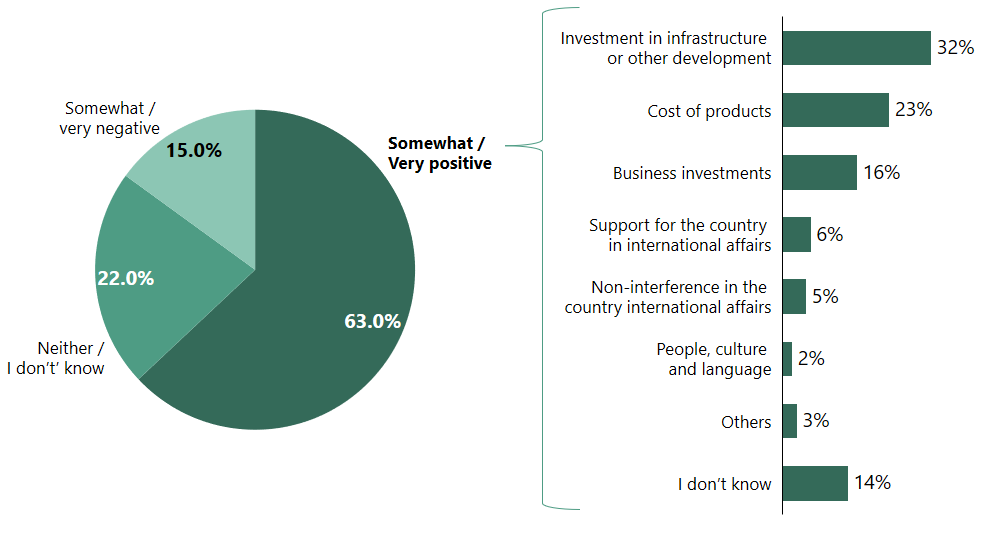
Generally speaking, Africans recognize the importance of China’s economic activities in their homeland: across 35 countries, 69% of respondents say these activities have some or a lot of influence on the economy they live in.
Finally, a McKinsey extensive field survey shows how this perception is shared by almost all senior business and government leaders interviewed, that acknowledge how the Africa-China opportunity is larger than those presented by any other foreign partner, including Brazil, the European Union, India, the UK and the United States.
Antonio Pilogallo, Team Lead at Infomineo
Sources:
Financial Times: https://www.ft.com/content/e7e81928-7f57-11e8-bc55-50daf11b720d
Financial Times: https://www.ft.com/content/7699d13a-806a-11e8-af48-190d103e32a4
Financial Times: https://www.ft.com/content/3c437b42-c6f8-11e8-ba8f-ee390057b8c9
UNCTAD: https://unctad.org/en/PublicationsLibrary/wir2018_en.pdf
Afrobarometer: http://afrobarometer.org/sites/default/files/publications/Dispatches/ab_r6_dispatchno122_perceptions_of_china_in_africa1.pdf
Quartz Africa: https://qz.com/africa/1335418/chinese-leaders-visit-africa-more-often-than-you-think-and-not-always-the-places-you-expect/
Quartz Africa: https://qz.com/africa/1324618/china-is-kenyas-largest-creditor-with-72-of-total-bilateral-debt/
Quartz Africa: https://qz.com/africa/1323666/china-and-djibouti-have-launched-africas-biggest-free-trade-zone/
Quartz Africa: https://qz.com/africa/1310072/china-in-nigerias-economy-from-huawei-to-small-businesses/
Quartz Africa: https://qz.com/africa/1297093/china-will-host-the-china-africa-defense-forum/
Quartz Africa: https://qz.com/africa/1291372/chinas-yuan-gets-support-from-africa-central-banks-to-replace-us-dollar-reserve/
Quartz Africa: https://qz.com/africa/1283192/chinas-tourism-to-africa-is-growing-as-visa-rules-are-relaxed/
Quartz Africa: https://qz.com/africa/661331/south-africa-is-targeting-chinese-and-indian-tourists-after-relaxing-its-visa-rules/
Quartz Africa: https://qz.com/africa/1030978/china-is-training-africas-next-generation-of-aviation-and-transport-officials/
Quartz Africa: https://qz.com/africa/1351749/chinas-confucius-institutes-in-africa-spread-mandarin-culture/
https://eng.yidaiyilu.gov.cn/jcsj/dsjkydyl/40513.htm
https://www.focac.org/eng/ltjj_3/ltffcy/
https://www.sciencedirect.com/science/article/pii/S0016718517303056
http://www.xinhuanet.com/english/2018-05/29/c_137213337.htm
http://www.sais-cari.org/data-chinese-loans-and-aid-to-africa
You may also like
Warning: Undefined variable $content in /var/www/sdomains/nexatestwp.com/infomineo.nexatestwp.com/public_html/wp-content/themes/infomineo/single.php on line 235
Warning: Undefined variable $content in /var/www/sdomains/nexatestwp.com/infomineo.nexatestwp.com/public_html/wp-content/themes/infomineo/single.php on line 235
Warning: Undefined variable $content in /var/www/sdomains/nexatestwp.com/infomineo.nexatestwp.com/public_html/wp-content/themes/infomineo/single.php on line 235
Warning: Undefined variable $content in /var/www/sdomains/nexatestwp.com/infomineo.nexatestwp.com/public_html/wp-content/themes/infomineo/single.php on line 235
Warning: Undefined variable $content in /var/www/sdomains/nexatestwp.com/infomineo.nexatestwp.com/public_html/wp-content/themes/infomineo/single.php on line 235
Warning: Undefined variable $content in /var/www/sdomains/nexatestwp.com/infomineo.nexatestwp.com/public_html/wp-content/themes/infomineo/single.php on line 235



